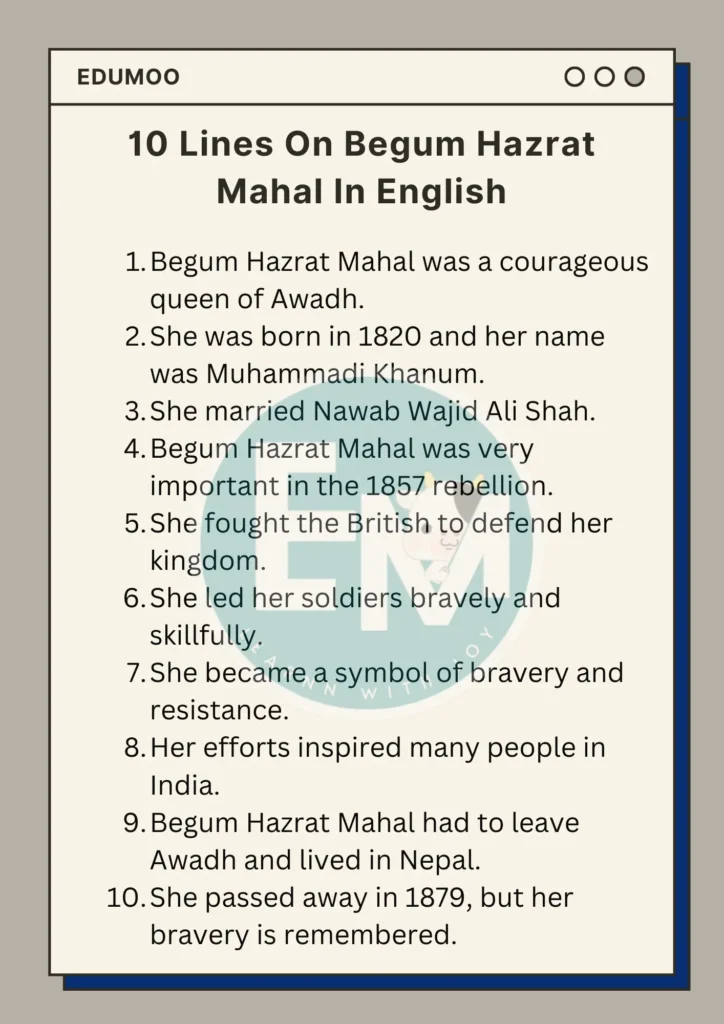Begum Hazrat Mahal was a remarkable woman who showed great courage and strength during challenging times. Known for her bravery, she became a key figure in India’s struggle for independence. Her life is an inspiring story of determination and leadership. Let’s learn more about her with these 10 lines on Begum Hazrat Mahal.
10 Lines On Begum Hazrat Mahal In English
- Begum Hazrat Mahal was a courageous queen of Awadh.
- She was born in 1820 and her name was Muhammadi Khanum.
- She married Nawab Wajid Ali Shah.
- Begum Hazrat Mahal was very important in the 1857 rebellion.
- She fought the British to defend her kingdom.
- She led her soldiers bravely and skillfully.
- She became a symbol of bravery and resistance.
- Her efforts inspired many people in India.
- Begum Hazrat Mahal had to leave Awadh and lived in Nepal.
- She passed away in 1879, but her bravery is remembered.

Essay On Begum Hazrat Mahal In English In 200 Words
Begum Hazrat Mahal was a brave and courageous queen of Awadh, born in 1820 as Muhammadi Khanum. She became known for her strength and leadership, especially during the Indian Rebellion of 1857. Married to Nawab Wajid Ali Shah, she stepped into the spotlight when her husband was exiled by the British.
During the rebellion, Begum Hazrat Mahal took charge and led her troops against the British forces. She fought with great skill and determination to protect her kingdom and people. Her leadership and courage made her a significant figure in India’s struggle for independence. Many people were inspired by her efforts and bravery.
Begum Hazrat Mahal faced many challenges, but she never gave up. She became a symbol of resistance and inspired others to fight for their rights. After the rebellion, she had to leave Awadh and lived in Nepal. Despite the hardships, she continued to support the fight for freedom.
Begum Hazrat Mahal passed away in 1879, but her legacy lives on. She is remembered as a strong and brave leader who stood up against oppression. Her story is a reminder of the sacrifices made by many for India’s independence. Even today, she is celebrated as a symbol of courage and determination.
| Also Read: 10 Lines On Jyotiba Phule |
Essay On Begum Hazrat Mahal In English In 700 Words
Begum Hazrat Mahal was a brave and courageous queen of Awadh, a region in northern India. She was born in 1820 and her original name was Muhammadi Khanum
Begum Hazrat Mahal’s life changed when she married Nawab Wajid Ali Shah, the ruler of Awadh. She became a part of the royal family and was given the title “Begum,” which means a noble lady. She was known for her intelligence, beauty, and strong will. However, her life took a dramatic turn when the British decided to annex Awadh.
In 1856, the British East India Company annexed Awadh and exiled Nawab Wajid Ali Shah to Calcutta (now Kolkata). This move was part of the British strategy to expand their control over India. The people of Awadh were unhappy with this decision, and there was a lot of unrest. It was during this time that Begum Hazrat Mahal stepped forward to lead her people.
In 1857, a major rebellion, known as the Indian Rebellion of 1857 or the First War of Indian Independence, broke out against British rule. Begum Hazrat Mahal played a crucial role in this uprising. She took charge of the rebellion in Awadh and fought valiantly to protect her kingdom from the British forces. She proved to be an excellent leader and strategist, inspiring her troops and the people of Awadh to stand up against the British.
Begum Hazrat Mahal’s leadership during the rebellion was remarkable. She rallied her forces and managed to capture Lucknow, the capital of Awadh, from the British. She established her authority and worked tirelessly to strengthen the defense of the city. Her bravery and determination were evident as she led her troops in battle, often risking her own life.
Despite her efforts, the rebellion faced many challenges. The British were powerful and had more resources. They launched a counter-attack and after several months of fierce fighting, they managed to recapture Lucknow. Begum Hazrat Mahal did not give up easily. She continued to resist the British, moving from place to place to avoid capture. Her resilience and spirit of defiance became a symbol of resistance against British rule.
Begum Hazrat Mahal’s struggle did not end with the fall of Lucknow. She sought refuge in Nepal, where she continued to support the cause of Indian independence. She tried to garner support from other rulers and leaders, but the British were determined to suppress any resistance. Despite the odds, she remained committed to her cause and never wavered in her fight against the British.
Begum Hazrat Mahal passed away in 1879 in Nepal. Even though she did not live to see India gain independence, her contributions to the struggle for freedom are remembered and honored. She is regarded as one of the early pioneers of India’s independence movement. Her bravery, leadership, and unwavering commitment to her people have made her a lasting symbol of resistance and courage.
Begum Hazrat Mahal’s legacy continues to inspire generations. She showed that women could be strong leaders and play a vital role in shaping the future of their country. Her story is a reminder of the sacrifices made by countless individuals in the fight for freedom. She taught us that standing up for what is right, even in the face of adversity, is important.
Today, Begum Hazrat Mahal is remembered as a national heroine. Schools, colleges, and public places have been named after her in honor of her contributions. Her life and achievements are celebrated in books, movies, and history lessons, ensuring that her legacy lives on.
In conclusion, Begum Hazrat Mahal was a remarkable woman who displayed immense courage and leadership during a critical time in India’s history. Her fight against British rule and her efforts to protect her kingdom have left a lasting impact. She remains a symbol of strength and resilience, inspiring all of us to stand up for justice and freedom. Begum Hazrat Mahal’s story is a testament to the power of determination and the enduring spirit of a true leader.
Conclusion
Today, we have learnt 10 lines on Begum Hazrat Mahal. Begum Hazrat Mahal’s story reminds us of the importance of bravery and determination. Her contributions to India’s freedom struggle are remembered and honored. Even today, she is a symbol of strength and courage for many. Remembering her helps us appreciate the sacrifices made for our country’s independence.

